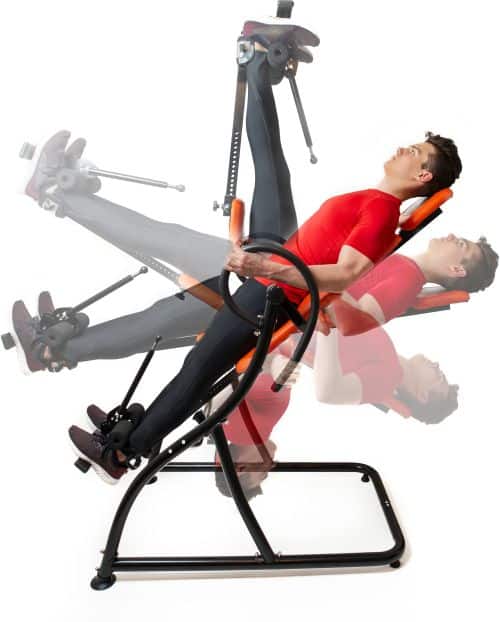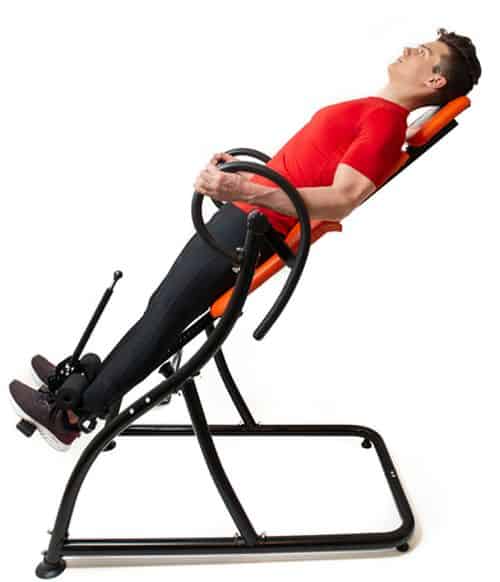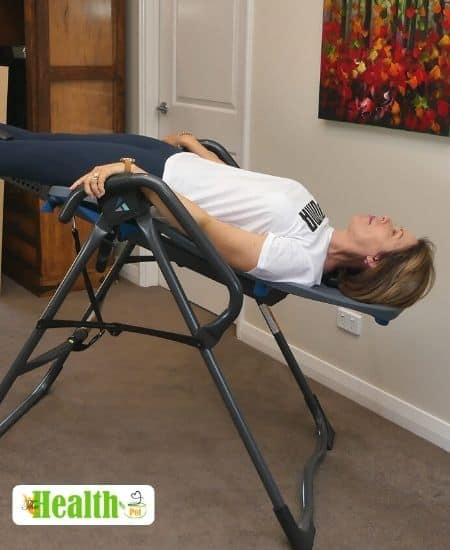Whether you have just invested in an inversion table or are thinking about buying one, one of the questions you might be wondering about is how long or how often should you hang upside down on an inversion table to stay safe.
If you’re a beginner, start with a moderate angle (say, 30 degrees instead of a full 180-degree inversion) and do this for 30 seconds to 1 minute only. Increase your tilt and time gradually, progressing to 3-5 minutes over time. Doing short durations of inversion more often is better than a long session in one go.
To understand inversion table safety, it’s important to know what inversion tables are used for, how to use an inversion table, and the benefits of inversion therapy. I’ll explain all these in this guide, so hop on!
The Purpose of Inversion Tables

- Check out My Full Review: The Teeter Inversion Table Here
Inversion tables offer various benefits, but you need to use them correctly to achieve the desired results.
More importantly, you should listen to your body instead of setting your mind to doing fixed times and frequency. If, during an inversion, you feel any discomfort, nausea, or lightheadedness, slowly reverse to the upright position and take a break.
Inversion tables may look unconventional to those seeing one for the first time, but they do serve a purpose.
As an inversion table tilts your body to the desired incline, you get to reduce day-to-day pressure on your spine, stretch the back muscles, decompress the vertebrae, improve blood circulation, provide pain relief, increase mobility, and even correct your posture.

For these benefits, inversion tables are used by people suffering from general back pain, stiff or tense back muscles, sciatica (read about is walking on a treadmill good for sciatica ), and poor posture. They’re even used for general relaxation and stretching purposes.
How to Use an Inversion Table
Using an inversion table is as simple as lying back in position, securing your feet, and using the assistive sidebars to tilt to the desired angle, which can then be locked in place.
Make sure that your body remains correctly aligned with the back and the headrest and that your ankles are fully secured. Inversion tables should feel comfortable and in no way physically challenging.
IMPORTANT: Before using an inversion table or other forms of inversion therapy, it’s best to first seek your doctor’s approval. You should never attempt to use one if you have these health conditions: hypertension, heart ailment, glaucoma, hernia, fractures in the back or leg, and osteoporosis.
How Long Should You Stay Upside Down on an Inversion Table?
Being inverted increases blood flow to the brain. While this offers various benefits, such as increasing oxygen and nutrients to the brain, staying inverted for a long period will lead to lightheadedness, dizziness, fainting, and other adverse reactions.
Start by doing moderate inclines for 30 seconds to 1 minute, then when you’re comfortable using the device, you can slowly increase your tilt and time to full inversion. There is no cut-and-dried formula to the time and frequency of using the inversion table, but 3 to 5 minutes can already give you the benefits you’re looking for.
At any rate, as soon as you feel lightheaded, dizzy, or uncomfortable, it’s best to slowly decrease the angle of inversion till you’re upright. Call for assistance and take a rest.
How Often Should You Use an Inversion Table?
The answer to this differs from one person to another, and it also depends on how long your sessions are. In general, for sessions that last up to 5 minutes, you can do inversions 5 times a week on separate days without any problem.
The Pros and Cons of Inversion Tables

To help you make up your mind, here’s a balanced look at inversion tables.
Pros
- Easy to use
- Can relieve spinal tension and provide back pain relief
- Can help improve posture
- Can strengthen core muscles
- Improves blood circulation, which is beneficial to cognition and brain health
- Good for stretching and decompressing the spine
- Generally affordable
- Foldable and storable
- Can be used for exercises, such as abdominal exercises (depending on the inversion table – always check first)
Cons
- Can cause lightheadedness and dizziness if not used correctly
- Inversion tables may break at any time during use, which may cause injury
- The long-term benefits of inversion tables are not widely proven
Inversion Table Alternatives
There are alternatives to inversion tables, but do they offer the same benefits?
For example, yoga is a great form of exercise for stretching and increasing overall mobility and flexibility. It can improve fitness and strengthen muscles and joints. Some yoga poses that involve varying degrees of inversion are downward dog, Uttanasana, and headstands/handstands.

Other alternative inversion practices include aerial yoga swing exercises, pole dancing, and gymnastics.
Are Inversion Tables Effective?
While there is a no evidence supporting the claimed long-term effectiveness of inversion tables, many users swear by the benefits of using one. This goes to show that inversion tables can work for some people.
If you’re on the fence about buying an inversion table, I recommend that you try out one first, if possible.

Assess how you feel about using it. Are you comfortable? Do you feel safe? Is it easy to use? Then assess the after-effects, which can be an improvement in posture, back tension relief, and mental clarity.
Conclusion
Overall, you should only stay upside down on an inversion table for a few minutes. The sessions should feel comfortable and safe.
If you feel discomfort, lightheadedness, or dizziness, you should slowly return to the upright position or reduce the angle of inversion.
To improve overall safety, consider getting assistance whenever using an inversion table, especially if you are a beginner.
If you are not sure about using or buying an inversion table, you can also try traditional yoga, aerial yoga swinging, pole dancing, and gymnastics.
Written by Kathleen Langdon – TheHealthPot.com Founder
Certified Personal Trainer (CPT), Certified Corrective Exercise Specialist (CES)
Kathleen, a mother of two, struggled with ongoing weight and health issues. She created this website after she turned her life around. She built Thehealthpot.com to help inspire and motivate others with their fitness goals. Read more about Kathleen here.


